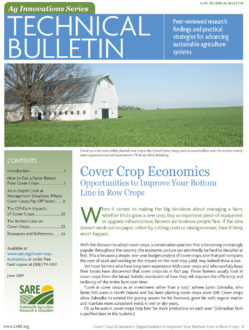Farmers around the country are planting cover crops on millions of acres to protect and improve the soil, and the more that farmers use cover crops, the more they value this conservation practice. Cover Crop Economics: Opportunities to Improve Your Bottom Line in Row Crops looks at the economics of cover crops in corn and soybean rotations to help farmers answer that big question, when do cover crops pay?
The key, says North Dakota farmer Justin Zahradka, who has been planting cover crops since 2011, is to “look at cover crops as an investment rather than a cost.”
Based primarily on yield and economic data gathered through five years of national cover crop surveys, Cover Crop Economics: Opportunities to Improve Your Bottom Line in Row Crops addresses the kinds of economic returns that can be expected from cover crops, both under various management scenarios and as cover crops improve soil health over time. Because there is no one-size-fits-all answer to when cover crops start paying for themselves, Cover Crop Economics: Opportunities to Improve Your Bottom Line in Row Crops takes a holistic approach, exploring seven common management situations for commodity farmers that can affect how quickly they receive a positive net return from cover crops:
- Herbicide-resistant weeds are a problem
- Cover crops are grazed
- Soil compaction is an issue
- Cover crops are used to speed up and ease the transition to no-till
- Soil moisture is at a deficit or irrigation is needed
- Fertilizer costs are high or manure nutrients need to be sequestered
- Incentive payments are received for using cover crops
Presentation on the report
This presentation features Cover Crop Economics: Opportunities to Improve Your Bottom Line in Row Crops author Rob Myers discussing results from the report.
